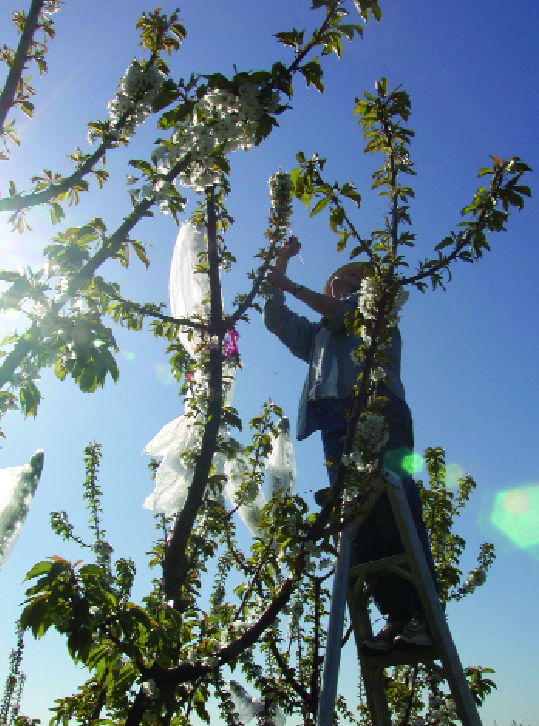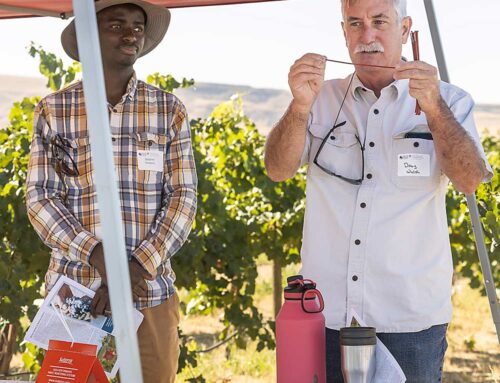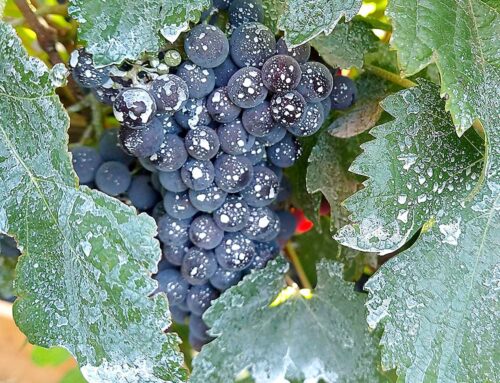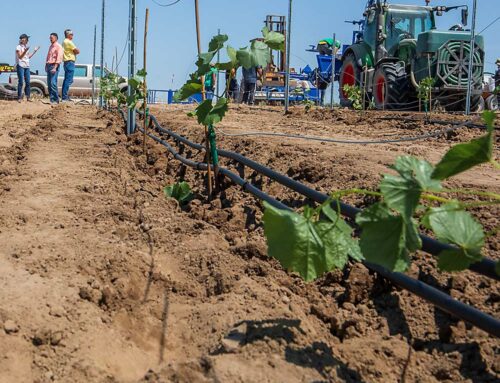
Dr. Amy Iezzoni applies pollen to a flower style with a glass rod—part of the process of making cherry crosses.
An aggressive sweet cherry breeding program will help Washington and Oregon growers remain competitive, providing new cultivars that extend the ripening season, minimize production costs, and have superior eating quality.
The ambitious sweet cherry breeding project received a total funding commitment of $260,000 for the first three years from the Washington Tree Fruit Research Commission and the Oregon Sweet Cherry Commission. Dr. Matthew Whiting, Washington State University cherry horticulturist at the Irrigated Agricultural Research and Extension Center in Prosser, is leading the new sweet cherry breeding and genetics program, with Dr. Amy Iezzoni of Michigan State University serving as breeder and consultant.
Last year, Whiting and Iezzoni began making crosses and planting seeds as part of a pilot project to evaluate the feasibility of starting a new sweet cherry breeding program. The seeds from this effort, some 4,460 seeds from 64 crosses were planted in a commercial nursery last fall. At press time for the Good Fruit Grower, the number of seeds that germinated from last fall’s planting and grew into a seedling had not been counted.
Goals
The goal of the breeding project is to develop new scion cultivars that will increase the profitability of the Washington and Oregon sweet cherry industries. Whiting is after a full-season series of cultivars that exceed the current varieties available and improve on fruit quality traits.
Breeding programs are expensive and long term. It can take years before a new variety is released for commercial production. Much of the cost is in evaluating the thousands of seedlings that, at least until fruiting, are all potential selections.
Whiting recognizes the need to maximize the program’s cost effectiveness. To keep costs down, technicians and staff will be hired as needed as the program matures, and the breeder is employed as a consultant, not year-round. Land costs are kept low by germinating and growing the seeds from the crosses at a commercial nursery. Selections will be field tested in trials at four locations all at once, from north central Washington to The Dalles, Oregon.
But one of the major expenses involved in the program is the time it takes for new seedlings to come into bearing—when fruit can be evaluated. Whiting has also targeted this juvenility period of young cherry trees as an area where costs can be minimized.
“We’re trying to eliminate those areas that add time to the project as quickly as possible,” he said. “That’s where the real savings are.” Two side research projects—one dealing with DNA screening and the other studying ways to speed up flowering and fruiting of seedlings—should help shorten the time it takes to release new varieties. “Ultimately, selections will be based on fruit characteristics,” he said, which is why such emphasis is placed on getting seedlings to bear fruit as early as possible.
One way to encourage earlier fruiting would be to use precocious Gisela rootstocks, G.5 and G.6. Unfortunately, the royalty fee and tree cost of Gisela rootstocks are prohibitive when dealing with the thousands of potential seedlings expected to come from the breeding program. To get around the high cost of Gisela rootstock, Whiting will compare several different methods of inducing the scion wood to flower early.
One method will use ethephon (Ethrel) on seedlings to see if applications will hasten flower bud induction and fruiting. Previous trials by WSU’s Dr. Don Elfving showed that ethephon improved the precocity of cherry seedlings, although the response was variable among cultivars. Whiting will also try using sleeping eye trees that are budded in the fall, dug out in the spring, and then planted.
Many apple growers are successfully using sleeping eyes, but there is little experience of using them in sweet cherry production. He will use sleeping eye trees on the precocious hybrid rootstock MxM14. Whiting also will study if tissue or buds from a juvenile seedling will give the same response as tissue from a mature tree. “We know that budding a one-year-old nursery rootstock seedling won’t change the genetics.But if we go to the expense of putting it on a precocious rootstock, we want to see it fruiting in three years instead of five.”
DNA screening
Another component of the project is to develop molecular markers for fruit size and quality traits and powdery mildew resistance, he explained.
The use of molecular tools will make the breeding program more efficient because the seedlings can be screened for quality characteristics, self-fertility, powdery mildew resistance, and other traits, eliminating undesirable crosses before they are planted in the field.
“By using molecular markers, you don’t go to the seedling stage,” Iezzoni said. “With molecular markers, you can cut them off right from the start.” Iezzoni, who directs a tart cherry breeding program in Michigan, recently received a $400,000 grant from the U.S. Department of Agriculture to develop genomic tools to help identify genetic traits for sweet cherry breeding, and will collaborate with Whiting in her molecular research.
Work to develop powdery mildew resistant cultivars was started at Prosser several years ago by Dr. Greg Lang and graduate student Jim Olmstead. The nearly 300 seedlings screened by Lang and Olmstead will be used to identify candidate DNA markers for powdery mildew resistance.






Leave A Comment